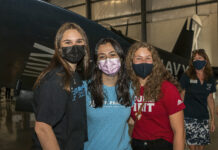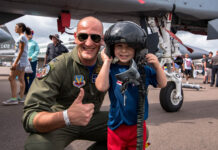Squinting into the sun on my dad’s shoulders with my veteran grandpa by our side, the Thunderbirds zipped overhead. I was in awe. It was 1987 in Rockford, Illinois and one of my first memories.
Since then, my life path has bumped into aviation over the years; I took a discovery flight course (what a rush!), jumped out of a couple planes, watched crop-dusters in the 600-resident farming community in which I grew up, saw one of my best friends become a commercial pilot, and watched performers from the Chicago Air Show fly over my home every August. Despite this, I wouldn’t call myself an aviation enthusiast.
I do, however, love events and have stumbled into becoming an expert over the last nine years and that’s why I’m here. In 2007, I started an event company out of my kitchen — Red Frog Events — that has gone on to produce hundreds of events, large and small, nationwide, including music festivals, running races, beer festivals, and many more. As the years passed, we became pretty adept at putting on smooth, fun events…no matter the type.
We weren’t necessarily music lovers, serious runners, or beer lovers; we just loved the challenge and satisfaction of managing the elusive, perfect event and providing our guests with the experience of their lives.
Then, in 2013, I stumbled upon an article that mentioned EAA AirVenture in Oshkosh drew 400,000 people annually. 400,000! I had to see it, so Ryan (my brother-in-law and business partner) and I drove up to Oshkosh that summer and experienced the event. That got me more intrigued, so I went to a few more air shows around the country over the next couple years to spectate, observe, and learn.
I was simultaneously amazed and disappointed. I got a rush when I saw the jets fly by or saw a pilot complete a maneuver I didn’t know was possible, and I witnessed what seemed like a very large and loyal base of fans. On the flip side, I waited in traffic, couldn’t find parking, waited in entry lines, struggled to find shade, and easily became bored when there wasn’t action in the sky.
The air show itself was spectacular, but — between the FAA, the pilot’s abilities, the air traffic and so on – I was clueless as to how it all came together. Yet, curiously, the event operations and their shortcomings seemed like the easy part to me. It dawned on me that our company’s competencies and what we love are inversed from those competencies of the air show industry and what you love. So I kept investigating.
At the ICAS Convention last December, Ryan spoke in a couple sessions and gave tips on event operations, experience, and marketing, while I learned more about the dynamics of the industry and that many of you are nobly working in your spare time, helping to raise money for a non-profit and helping to build awareness for aviation while pursuing your passion for an industry you love.
From my early observations, it seems as if many of the shows aren’t being run like a business, but rather as a hobby with the goal that they make some money for their non-profit. Money is definitely being left on the table and, as a result, the non-profits are the ones suffering.
You can achieve both. Ryan and I visited the St. Jude Children’s Research Hospital in Memphis in 2009, and were deeply moved by the hospital’s success in saving children’s lives (80 percent today, up from 20 percent when the hospital opened), and the fact that no family ever pays a dime for treatment. We decided to do something about it, and — in 2011 — made a commitment to raise $25 million for the hospital. I’m proud to say that we’re already half way there — $12.7 million to be exact – and the St. Jude Red Frog Events Proton Therapy Center, the first ever proton therapy center specifically designed to treat childhood cancer, opened last December. Red Frog is a for-profit company, but we’ve been able to raise a significant amount of money for a non-profit we care about. (If you’re curious about the great things happening at St. Jude Children’s Research Hospital, I encourage you to check out their website at www.stjude.org and to make a donation.)
Red Frog’s goal when creating an event is to achieve an unforgettable, positive experience in every facet, from the first click on our website to the exit from the parking lot. So good, in fact, that we expect our customers to tell their friends about the experience (whether that’s through a good, old-fashioned face-to-face conversation or via social media).
Based on my limited and early observations, I don’t think this is happening in the air show community. Based on what we have learned so far, the industry as a whole has four key areas in which to improve upon, helping to maximize annual earnings (short-term and long-term) for your air show business and the non-profit organizations that you support.
Experience
ICAS studies have shown that the average attendee is not, in fact, an aviation enthusiast. They’re average Joes looking to be entertained with their family for the weekend (much like me in Rockford in 1987). The air show is grand and exciting, but –after a short attention span kicks in — then what? For the average Joe, static display aircraft will hold their attention for a bit, but then what? My observation is that the industry will benefit from improvements and innovations that focus on improving the experience of the customers who attend your event, the kind of experience that your attendees have come to expect from the other events that they attend.
What about stages with bands, celebrity appearances, carnival rides, specialty craft beer tents, vineyards for the wine lovers, entire aviation themed arcades? Our experience has demonstrated that the more entertainment available to your attendees, the better experience they’ll have. The better experience they have, the more likely they’ll stay. The more they stay, the more the per capita spending goes up and the more likely they are to have a positive experience and come back next year.
Improving upon the overall experience is also how to slow or reverse the decline of millennial attendance. They expect more than air show audiences of a generation ago and their attention spans are shorter. One way to address this while driving revenue is through sponsorship.
Sponsorship
Sponsorship revenue is not being maximized industry wide and I’m confident that it’s possible to get big national brands behind the industry and your attractive demographics with real dollars. My hunch is that the fragmentation of the shows makes it difficult to get and keep the attention of national sponsors and that the overall lack of experts familiar with national sponsorship in the air show community further limits opportunities.
At Firefly Music Festival, we draw sponsorship revenue into the millions while also heightening the experience for our attendees because of creative activations.
For example, Dogfish Head Brewery, our exclusive craft beer partner, builds a massive 164 x 100 foot “Brewery” complete with televisions playing live performances from around the festival grounds, outdoor seating for hundreds, and serving the custom-brewed Firefly Ale.
Our partner Stubhub helped us solve a problem. The early feedback from our attendees was that our coffee options were too limited, so we created the Stubhub Coffee House. Within it are elevated coffee options and a stage with several acoustic performances throughout the day. We solved a problem, increased the festival experience, and brought in sponsorship revenue in one fell swoop.
For our Warrior Dash event, a five kilometer obstacle course race, Delta Faucets helped solve a problem, too. The final obstacle at every Warrior Dash is a barbed wire covered mud pit, which guarantees every runner finishes covered in mud. Having sufficient shower options for thousands of runners without a direct water supply was a challenge for years. Delta created a custom shower with dozens of shower heads and an endless water supply with the tagline, “A messy life is a happy life.” Our customers loved it and it drove social media engagement.
Social Media
We’ve used organic and paid social media strategies heavily from the beginning and, as a result, have amassed a following of over 1.5 million people for Warrior Dash alone. This has allowed us to engage with our customers and has given us a voice we’ve leveraged to help our events grow. I think the air show industry has underutilized this tool.
At Firefly, we build custom photo structures with hash tags like #firefly2015 built right into it. Throughout the festival our guests take pictures of their respective groups and post them on social media, driving exposure to the event.
Event Operations
As your attendees approach the event, is there clear signage? Are there professional and trained parking attendants readily available? Is the entry process painless? Are there any lines anywhere? Are the portable toilets clean? Are there enough of them? Are your concession lines moving? Is there adequate shade? Are your staff and volunteers trained and smiling? Are there great souvenirs available? Do your attendees have great cell reception?
These are the basics. When the answer to all of these isn’t unequivocally yes, then many attendees simply won’t return no matter what happened in the sky that day.
From our perspective as an events production company, the air show industry has unique and exciting promise and challenges. We are excited to be a part of it and eager to begin putting our unique skill set to work on both that promise and those challenges.








